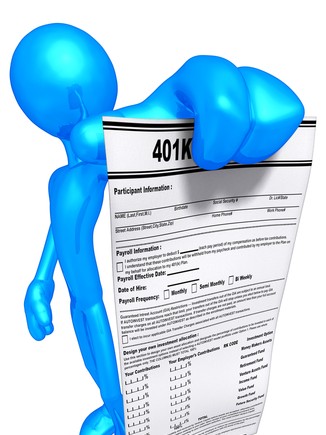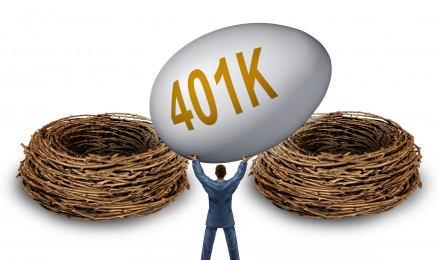Many employers will often offer one type of retirement plan or another. Some of them will offer a 401(k). What is a 401k? This type of savings plan often enables both the employee and the employer to contribute money into the same employee’s account that also offers a tax-deferred incentive to save money toward retirement.
The IRS calls money put into a 401(k) plan as being “elective contributions” because the employee chooses how much he or she would like to contribute to their plan and the employer chooses how much they will match the contributions. 401(k) plans have Federal limits on how much can be contributed per person each year. Although the money contributed is not included as wages on a W-2, it is counted as wages as far as withholding for social security and Medicare taxes.
The purpose of the 401 (k) is for retirement purposes. Money should be left in the account and not touched until retirement. The IRS does allow for money from a 401 (k) to be used for a “hardship distribution.” Penalties and taxes will be applied to such money unless the rules are followed for such withdrawals.
Types of 401 (k) Plans
There is a lot of different 401(k) plans on the market today. Basically, the Department of Labor says that each one of them will fall into one of three different categories: a traditional 401(k), a safe harbor 401(k), and an automatic enrollment 401(k) plan.
-
Traditional 401 (k)
Employers choosing this type of 401(k) will decide to either contribute a percentage of what the employee contributes, or match that amount – or both.
-
Safe Harbor 401(k)
This type of 401(k) allows the employer to match the employee’s contribution at a one-to-one ratio, up to three percent of the employee’s salary. After the three percent amount is matched, the employer contributes 50 cents to every dollar the employee contributes – but no more than five percent.
-
Automatic Enrollment 401(k)
An automatic enrollment plan means that an employer will automatically deduct deferrals from the salary and put it into a 401(k), unless the employee chooses to either opt out or to designate a specified amount. The IRS says that the employer must notify the employer prior to any deductions toward a 401(k).
Choosing the Distributions
A 401(k) provider usually presents a number of ways that the money in a 401(k) will be diversified. In most cases, employers will allow an employee to choose one plan out of as many as 12, or more. Money in a 401(k) is usually diversified between money markets, bonds, and stocks. The Wall Street Journal mentions that target-date funds seem to be the most popular at present, and this is a mix of stocks and bonds that invest more conservatively as retirement draws closer.
When finding out what is a 401(k) and choosing the best options for your plan, there are several things you want to consider most. These include the risk, the cost involved (fees), selecting a wise distribution between stocks and bonds – which depends on your age, and plan on leaving your money in the 401 (k) – without withdrawing any of it, advises Money.CNN.com.
Many employers will often offer one type of retirement plan or another. Some of them will offer a 401(k). What is a 401k? This type of savings plan often enables both the employee and the employer to contribute money into the same employee’s account that also offers a tax-deferred incentive to save money toward retirement.
The IRS calls money put into a 401(k) plan as being “elective contributions” because the employee chooses how much he or she would like to contribute to their plan and the employer chooses how much they will match the contributions. 401(k) plans have Federal limits on how much can be contributed per person each year. Although the money contributed is not included as wages on a W-2, it is counted as wages as far as withholding for social security and Medicare taxes.
The purpose of the 401 (k) is for retirement purposes. Money should be left in the account and not touched until retirement. The IRS does allow for money from a 401 (k) to be used for a “hardship distribution.” Penalties and taxes will be applied to such money unless the rules are followed for such withdrawals.
Types of 401 (k) Plans
There is a lot of different 401(k) plans on the market today. Basically, the Department of Labor says that each one of them will fall into one of three different categories: a traditional 401(k), a safe harbor 401(k), and an automatic enrollment 401(k) plan.
-
Traditional 401 (k)
Employers choosing this type of 401(k) will decide to either contribute a percentage of what the employee contributes, or match that amount – or both.
-
Safe Harbor 401(k)
This type of 401(k) allows the employer to match the employee’s contribution at a one-to-one ratio, up to three percent of the employee’s salary. After the three percent amount is matched, the employer contributes 50 cents to every dollar the employee contributes – but no more than five percent.
-
Automatic Enrollment 401(k)
An automatic enrollment plan means that an employer will automatically deduct deferrals from the salary and put it into a 401(k), unless the employee chooses to either opt out or to designate a specified amount. The IRS says that the employer must notify the employer prior to any deductions toward a 401(k).
Choosing the Distributions
A 401(k) provider usually presents a number of ways that the money in a 401(k) will be diversified. In most cases, employers will allow an employee to choose one plan out of as many as 12, or more. Money in a 401(k) is usually diversified between money markets, bonds, and stocks. The Wall Street Journal mentions that target-date funds seem to be the most popular at present, and this is a mix of stocks and bonds that invest more conservatively as retirement draws closer.
When finding out what is a 401(k) and choosing the best options for your plan, there are several things you want to consider most. These include the risk, the cost involved (fees), selecting a wise distribution between stocks and bonds – which depends on your age, and plan on leaving your money in the 401 (k) – without withdrawing any of it, advises Money.CNN.com.







